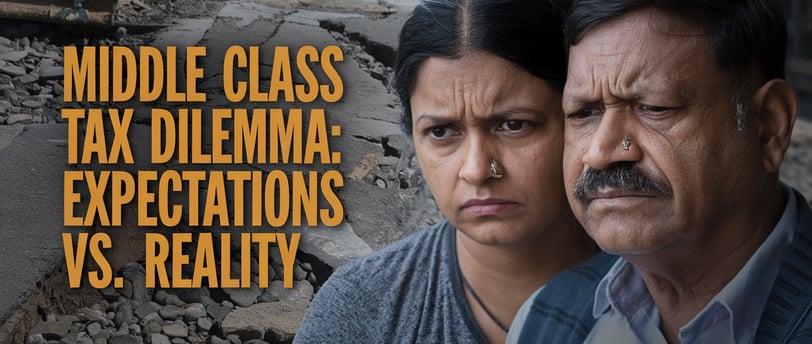Middle Class Tax Dilemma: Expectations vs Reality
Explore how taxation impacts India’s middle class and the challenges they face with inadequate infrastructure. Discover insights from beingMJ on the expectations versus reality of their contributions and the urgent need for better services.
beingMJ
9/23/20243 min read


In recent years, many middle-class families in India have found themselves in a difficult position. They contribute significantly to the economy through their taxes, yet they often feel the effects of inadequate infrastructure in their daily lives. This blog post explores the intricate relationship between the tax burden on the middle class and the pressing infrastructure challenges faced by the country.
💰 The Tax Situation for the Middle Class 📊
The Indian middle class, typically defined as those earning between ₹5 lakh and ₹30 lakh per year, is a vital part of the nation’s economic framework. This group not only fuels consumption but also plays a crucial role in tax revenue generation. They contribute through various means, including income tax, Goods and Services Tax (GST), and numerous other levies.
Despite their substantial contributions, many middle-class taxpayers feel neglected by the government. They often believe that the benefits of their taxes are not reflected in the services they receive. For instance, they pay taxes for education and healthcare but frequently encounter underfunded schools and overcrowded hospitals. This disconnect between tax contributions and public services can lead to feelings of disillusionment and frustration.
🚧 The Need for Better Infrastructure 🚍
Infrastructure is the backbone of any nation’s development. It encompasses transportation networks, healthcare facilities, educational institutions, and utilities such as water and electricity. In India, however, infrastructure is often lacking, particularly in urban areas where the middle class resides. Poor roads, inadequate public transport, and unreliable utilities pose significant challenges to daily life.
For the middle class, the consequences of poor infrastructure are immediate and often severe. Daily commutes can turn into hours of frustration due to traffic congestion on poorly maintained roads. Public transportation systems, while essential for many, are often overcrowded and inefficient. In addition, the lack of basic services like clean drinking water and reliable electricity affects both quality of life and productivity. These issues are not just inconveniences; they impact job performance, economic opportunities, and overall well-being.
⚖️ The Disconnect: Taxes vs. Services ❓
At the heart of the matter is the disconnect between the taxes paid by the middle class and the services received in return. They feel that their hard-earned money is not being used effectively. When they see a lack of investment in essential infrastructure, it fosters a sense of betrayal. This feeling is exacerbated by the visible disparities in wealth and development, with some areas flourishing while others remain neglected.
This disconnect leads to a growing distrust in the government. Many middle-class citizens question whether their taxes are being spent wisely. They often witness grand announcements about infrastructure projects, but these promises frequently do not translate into visible improvements. As a result, frustration grows, and the middle class may become increasingly disengaged from the political process.
🛠️ Possible Solutions 🔍
To bridge this gap and address the pressing infrastructure needs, the Indian government must focus on improving how tax revenues are used. Here are some potential solutions:
1. Increased Transparency
One of the most effective ways to rebuild trust between taxpayers and the government is through increased transparency. The government should openly share information about how tax revenues are allocated and spent. The project plans and outcomes can create a sense of accountability. When taxpayers can see how their money is being used, it fosters confidence in the system.
2. Targeted Investments
The government should prioritize investments in critical areas such as transportation, healthcare, and education. For instance, building better roads, improving public transportation systems, and upgrading healthcare facilities can have a significant positive impact on the middle class. It can improve the quality of life and make daily routines easier.
3. Public-Private Partnerships (PPP)
Collaborating with the private sector can bring in expertise and efficiency to infrastructure projects. Public-private partnerships (PPP) can help expedite the development of essential services and reduce the burden on government resources. By leveraging private investment and management, the government can improve infrastructure quality and service delivery.
4. Community Involvement
Engaging local communities in the planning and execution of infrastructure projects is crucial. When citizens have a say in what their neighborhoods need, projects are more likely to address real issues. Community input can ensure that infrastructure development meets the needs of those it intends to serve, making the projects more effective and widely accepted.
📈 Conclusion 🏙️
Paying taxes is a fundamental duty for the middle class in India, but the lack of adequate infrastructure can lead to frustration and disillusionment. By addressing these challenges head-on, the government can significantly improve the quality of life for millions of citizens. Enhancing infrastructure is not just about fostering economic growth; it’s about ensuring that every taxpayer feels their contributions are making a meaningful impact.
Building a better infrastructure system requires collaboration, transparency, and a commitment to meeting the needs of all citizens. When the government prioritizes these elements, it can help restore faith in the system and create a brighter future for the middle class and the nation as a whole. With thoughtful action and genuine engagement, India can transform its infrastructure landscape, benefiting everyone in the process.
Contact Us :
beingaimj@gmail.com
© 2024. All rights reserved.
